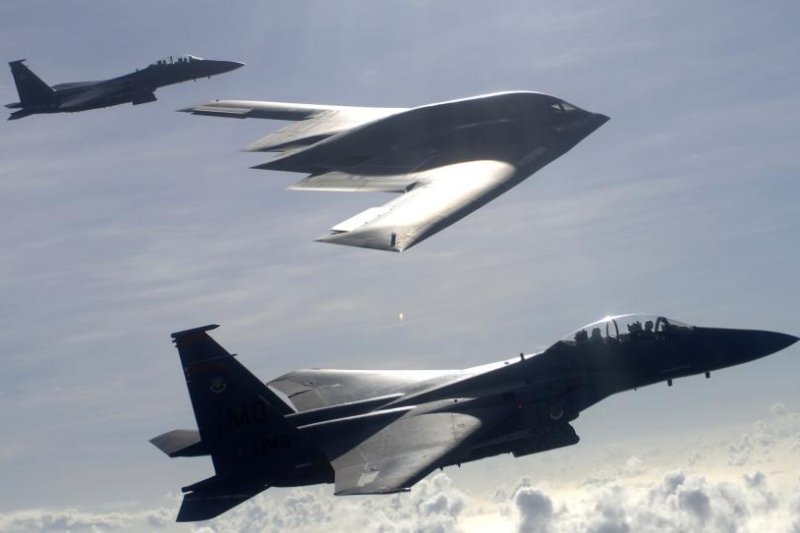The B-2 stealth bomber and F-15 fighters help the United States maintain air superiority capabilities against potential adversaries. U.S. Air Force photo
WASHINGTON, April 11 (UPI) -- The gap between the U.S. military's air superiority capabilities and that of potential adversaries is narrowing, a U.S. Air Force study says.
The solution to counter emerging threats is to view air superiority as a condition -- not capability -- using multi-domain solutions developed through a more agile acquisition process.
The disclosure was made by Lt. Gen. Mike Holmes, the Air Force deputy chief of staff for strategic plans and requirements, and Col. Alexus Grynkewich, the Air Superiority 2030 ECCT study lead, at a recent Air Force Association breakfast.
"After 25 years of being the only great power out there, we're returning to a world of great power competition," Holmes said. "We need to develop coordinated solutions that bring air, space, cyber, electronic environment and surface capabilities together to solve our problems.
"Air superiority is the most important thing the Air Force provides for the joint force in the tactical environment. I don't believe there is anyone in our armed forces who has ever fought a combined arms battle without complete control of the air, and there's no one in our armed forces who has ever fought a combined arms battle against an enemy armed with precision weapons."
Under direction of Air Force Chief of Staff Gen. Mark A. Welsh III, Air Force operators, acquirers and analysts have formed an enterprise capability collaboration team, or ECCT, to evaluate these problems and solve them, according to an Air Force news report.
The team looked to military experts, academia and industry for input and then conducted integrated planning, analysis and air superiority assessments for the year 2030 and beyond. More than 1,500 submissions were distilled into 220 initiatives. Those initiatives were then divided into various operational concepts.
Eventually the team determined an integrated and networked family of capabilities operating across air, space and cyberspace was the most viable option.
"There's no silver bullet," said Col. Alexus Grynkewich, the Air Superiority 2030 ECCT lead. "We have to match tech cycles -- some of them are really long. Engines take a long time to make, but information-age tech cycles are fast. Software updates are constantly moving. So how do you move from pacing yourself off industrial age mindsets to information age mindsets?"
The answer is parallel development of maturing technologies for sensors, mission systems, lethality and non-kinetic effects, on appropriate time cycles.
The next step, Grynkewich said, is to pull technologies out of each of those parallel efforts when they are ready, and then developing prototypes to determine if the developments are what's needed in the field.
"What we hope to lay out is a way to prototype and experiment with a number of concepts," Grynkewich said. "You can start building and then move forward if experimental capabilities are determined to make enough of a difference in highly contested environments of the future."















